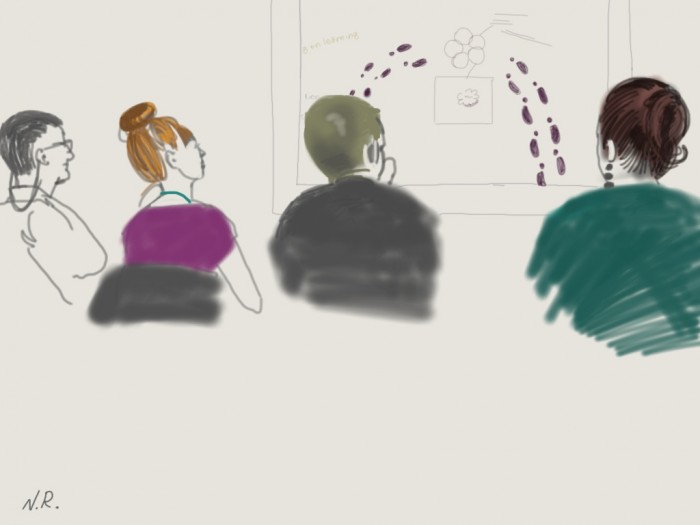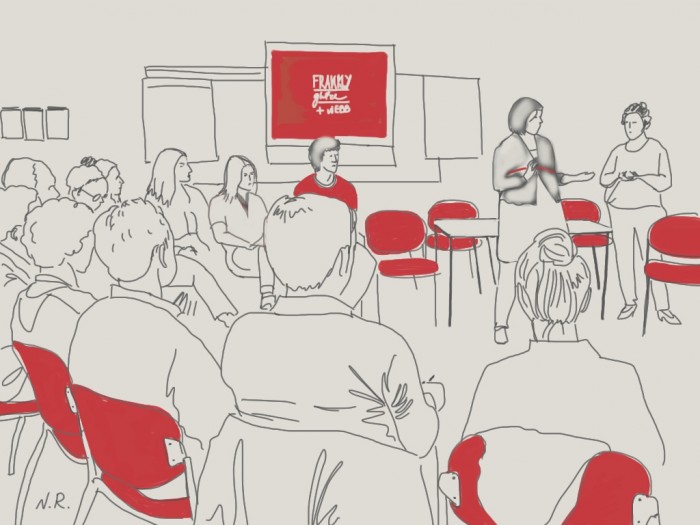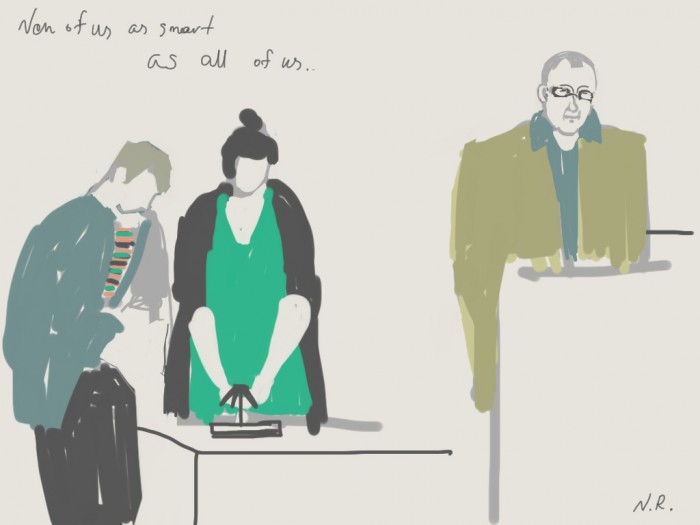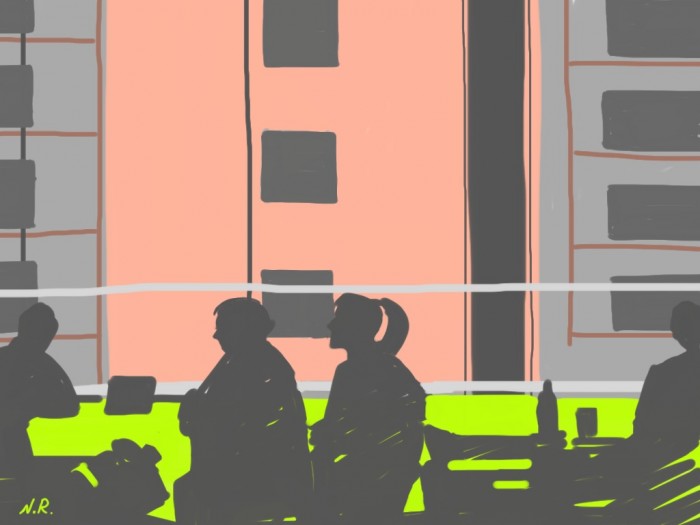For our joint conference with Museums Computer Group (MCG), we invited two bloggers to record the event – Nadja Ryzhakova used her iPad to capture the day in pictures and Laura Martin provided a written summary. Their work is shown below:
On July 11th 2012, under the title ‘Engaging Digital Audiences in Museums’, professionals from museums throughout the UK gathered to discuss and share experiences to bring two different worlds together – museums and technology.
“None of us is smart as all of us” – with this quotation and using a ‘Nail Puzzle’ challenge attempted by two willing volunteers to exemplify his points, Nick Winterbotham – Chair of Group for Education in Museums – asserted that dilemmas within museums should be met by professionals sharing experiences and observations. Only in these ways can results be achieved. We have important challenges knocking at our museum’s doors – we are living in a fast-changing society, with more and more different ways to digitally communicate and get engaged. Museums are having to find ways to beat the recession and the funding challenges it has brought, by demonstrating their importance in society.
As Nick quoted – “If you think education is expensive, try ignorance”.
Nick’s speech highlighted the importance of people as the real source of heritage. Museums are not for things, museums are for people. And to reach people it is necessary more than ever to engage with them through new paths. To be connected. But, what is the better way to reach these audiences? How should we use museum resources to achieve this?
 Matthew Cock – Head of Web at the British Museum reflected on his Museum’s approach to audiences and mobile apps. He recognised that mobile technology has changed the museum’s patrons and gone “from fun to fundamental”; only by understanding visitors needs can museums create suitable apps for them.
Matthew Cock – Head of Web at the British Museum reflected on his Museum’s approach to audiences and mobile apps. He recognised that mobile technology has changed the museum’s patrons and gone “from fun to fundamental”; only by understanding visitors needs can museums create suitable apps for them.
And not all visitors have the same needs to be fulfilled, they can be a mixture of social needs, intellectual, emotional, spiritual… Museums must use knowledge of their galleries and collections and explore different audience targets, considering how they can be connected through technology.
Until this point in the day we have talked about the ideas. About the spirit and the philosophy that leads the connection between these two not-so-separate worlds; museums and technology. But… What about the cases? What about the real practice?
Lucinda Blaser – Digital Projects Manager at Royal Museums Greenwich – told us about her experience with the 2009 project ‘Discovery sessions – new ways of learning’. Through a user generated tagging mobile device children were encouraged to create their own historical enquiries, and to learn more about topics which interested them. Lucinda noted that children behaved especially well in this scenario, showing more engagement with the galleries, being collaborative with other students and focusing well on the activity in hand. Teachers were crucially also included in the activity, by being provide with specially modified mobile devices which meant they could oversee student activities, send messages to them.
John Coburn – Project Coordinator ICT, Tyne & Wear Archives & Museums, Newcastle – discussed his recent app experiment which purposefully attempted a different approach from the norm. In his project, ‘Hidden Newcastle – failed inventors and body dredgers’, the focus was on people of Newcastle’s stories – 13 common people, not famous, not regularly commemorated ones. The criteria used to select these individual’s stories was that they displayed elements of failure, macabre, eccentricity… John was not looking to teach a deep knowledge of Newcastle’s history with this app, but instead was looking to engage users in a sensation of wonderment. The combination of the app with its unique stories and visiting the physical sites where events happened was intended to create a bond of affectivity and empathy, which is the motor that stirs public imagination, encouraging them to explore, and engage themselves.
 Isabel Benavides – Programme Manager (Family Outreach) at Museum of London – tackled one of the big concerns about the relationship between technologies and audiences: the impact. At the Museum they are trying to go beyond the traditional methods of enquiries, beyond the usual survey. By experimenting with technologies and a bit of imagination, they are focused on achieving something more valuable: subjective opinions. Communication between parents and children has been collected through digital devices such as easy speak microphones and cameras, allowing visitors to record their experiences and thoughts. Tools like ‘talking mats’ have been introduced, on which visitors can express the things they have enjoyed or not.
Isabel Benavides – Programme Manager (Family Outreach) at Museum of London – tackled one of the big concerns about the relationship between technologies and audiences: the impact. At the Museum they are trying to go beyond the traditional methods of enquiries, beyond the usual survey. By experimenting with technologies and a bit of imagination, they are focused on achieving something more valuable: subjective opinions. Communication between parents and children has been collected through digital devices such as easy speak microphones and cameras, allowing visitors to record their experiences and thoughts. Tools like ‘talking mats’ have been introduced, on which visitors can express the things they have enjoyed or not.
Martha Henson -Multimedia Producer at Wellcome Trust – told us about their on-line game ‘High Tea’. This game, set during the Opium Wars, has proved very successful on the web, and allowed Martha to collect useful information about what users knew and felt about in this historical period. Rather than a game primarily intended to attract audiences to their collection and exhibitions, it was a fun and engaging way to spread knowledge about this phenomenon in history, raising empathy and comprehension about it.
 During the workshops in the afternoon there was time to talk about doubts, concerns, ideas and issues. Probably, one of the most repeated words during the workshops and the end of day ‘unconference’ was sustainability. Despite being a conference about technology use, everyone was very clear that it is very necessary to resist being technology driven.
During the workshops in the afternoon there was time to talk about doubts, concerns, ideas and issues. Probably, one of the most repeated words during the workshops and the end of day ‘unconference’ was sustainability. Despite being a conference about technology use, everyone was very clear that it is very necessary to resist being technology driven.
Some of the most applauded themes to come out of discussions was the need for experimentation – piloting little activities, sharing best practices, consulting visitors about their needs and working in partnership with other departments, museums and organisations.
As a final reflection, I would pick up one of the sentences used to describe the state of the current situation and the aim of the conference: an intricate explosion – something with a lot of pieces and layers mixed together, which have to work together, combining slowly and without leaving anything behind, to finally explode. To finally blossom.
Our thanks to event bloggers Nadja Ryzhakova for her iPad illustrations and Laura Martin for her written report.


